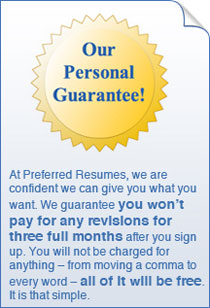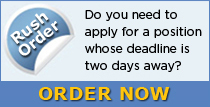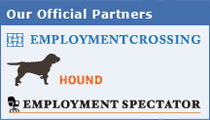How to Write a Resume for Your First Job
|
|
Writing a resume for your first job requires patience, attention to detail, and a little creativity. All job seekers need a strong resume if they want to compete for the best jobs. But while seasoned professionals can rely on their experience to generate initial interest from prospective employers, individuals hitting the job market for the first time do not have such a luxury. New professionals, therefore, need to work even harder to sell themselves to managers.
To start your resume, you will need to select a resume format. A functional resume is usually the best choice for a new professional, since it allows you to present your qualifications by functional skills as opposed to purely chronological job order. Since your work history will be brief, if not non-existent, you want to place the emphasis on your skills and knowledge.
Layout of a Functional Resume:
The layout you select for your resume should attract attention and create interest, but not detract from your overall presentation. Use of capitalization, bold lettering, underlining, indentations, different fonts, and white space can add variety to your resume and emphasize important information. The layout should be consistent throughout the individual sections of the resume, be visually appealing, and be easy for the reader to follow.
A functional resume has several parts, which are typically included in this order:
Name and Contact Information
Objective Statement
Education
Key Skills and Qualifications
Work Experience
Additional parts may include a section for Awards and Honors or References.
Name and Contact Information
You should include your name, full address, telephone number with area code, and email address (if applicable) at the very top of your resume. If you are currently residing at a temporary address, such as a student’s college address, you may include it in addition to your permanent address depending on the circumstances.
Objective Statement
If you choose to include an objective statement, it should be a concise and meaningful statement that describes your career goals in detail. An objective can include your goals in regards to your desired position title, industry, level of responsibility, and desired utilized skills. The elements included in your objective should be reinforced and supported throughout your resume and your cover letter.
A major mistake that many new professionals make is that they use a generalized objective statement. This is due to the fact that many men and women new to the workforce may not necessarily know what they are seeking in a position. They fear that by limiting the scope of the objective, that they are knocking themselves out of the running for positions that do not neatly match their objective – positions that they might otherwise be interesting in pursuing.
While this is true in some cases, it is advisable to either keep your objective focused and narrow, or completely leave it off your resume. A weak, unfocused objective in effect says nothing and will actually detract from your overall presentation.
Education
If you have a college degree, you should position the Education section near the top of your resume before your Key Skills and Qualifications. If you do not have a degree, the Education section should follow your Key Skills and Qualifications.
Your highest level of education achieved, whether you completed the program or not, should be the first listed in this section. All other schools you attended should follow.
For each individual school, list the following:
Name of the school
Dates you attended or graduated
Degrees earned (or degree program you were in, if not completed)
Major and minor subject areas
You may also list any honors, awards, Dean's list commendations, and GPAs if they will enhance this section of your resume. Any certifications or completed training courses that that are relevant to the position you are seeking should also be included.
Newer graduates can include a list of completed courses that are directly relevant to the type of position you are seeking. For example, a newly graduated Accounting major may want to highlight her course in Financial Accounting, Management Accounting, and Tax Accounting.
You should only include high school information if you do not have a college degree or if you achieved high commendation in some area that reinforces your career objectives.
Key Skills and Qualifications
This is the most critical section of a functional resume. The Skills section of your resume should highlight any relevant skills that might not otherwise be disclosed on your resume. This section will be highly individualized to both the person and the position they are seeking.
First, identify the key skills relevant to the type of position you are seeking. Some examples of key skills include customer relations, graphic design, marketing, leadership, and computer technology skills. It may be necessary to develop several different versions of your resume so that you are able effectively market yourself to a variety of jobs.
Next, rank the key skills in order of importance – you want the most important skill to appear at the top of your skills list. Then, under each of these key skill categories, include any information about yourself that demonstrates how you possess this skill. You can draw from any work experience, volunteer experience, schooling, extracurricular activities, or any other area as appropriate. As with the key skills themselves, rank this in order of importance so that the most relevant examples appear first.
Examples of key skills with supporting documentation are as follows:
Research
Designed questionnaire to assess customer needs
Identified sample population to be included in the study
Drafted analysis plan
Prepared survey results report and presented the results to the study team
Marketing and Distribution
Developed layout and organization of merchandise for a 25-page giftware catalog
Maintained accurate, up-to-date computer records of merchandise inventory, suppliers, customers, and shipping vendors.
Handled all facets of order receipt, processing, and fulfillment
Work Experience
Since you are new to the workforce, employers do not expect you to have much in terms of work experience. This section should be very brief. You should not provide any details of your responsibilities and accomplishments in this section (these should have been included under Key Skills and Qualifications). Instead, simply list your job title, the name of the employer, the location of the position, and your dates of employment as follows:
2004 – Present Customer Service Representative ABC Telecommunications
Baltimore, MD
2003 – 2004 Treasurer Omega Lambda Pi Fraternity
Baltimore, MD
2001 – 2003 Sales Assistant Magellan Imports
Washington, D.C.
Other Optional Sections:
Honors and Awards:
List any career, academic, leadership or athletic honors you have received. Academic awards may alternatively be listed under the Education section of the resume.
References:
You may include a statement declaring “References Available upon Request” if you need to fill space on your resume. Otherwise you should list references in a separate document. References should typically only be provided when requested or once it is clear that the competition for a position is narrowing. Do not include specific reference names or contact information on your resume.
Other Categories:
If there is additional information that you feel is important to include butt does not fit into any of these categories, you can create custom categories. Examples of custom categories may include Background, Professional Activities, and Recitals/Art Shows.




